We’ve started a lot of projects this year. One of our big ones this spring was planting blueberry bushes. I wanted a patch large enough to sustain our family of blueberry lovers throughout the year. This meant putting in a lot of bushes.
Man, I’m wishing we’d done this in our first year of homesteading! We’d be harvesting gallons of blueberries by now!
Actually, we did put in a dozen blueberry bushes at the beginning of our journey, but the goats escaped and demolished our poorly planned patch right away.
Two of those first plants survived and now live in the garden. We’ve been enjoying handfuls of berries from them for a couple of years now, but I wanted more.
I excitedly ordered 20 blueberry bushes from our local 4-H group. They were a good price ($6 each), and I didn’t have to worry about them being shipped. I got five plants of four different varieties to ensure good cross-pollination: Tifblue, Premier, Yadkin, and Powderblue.
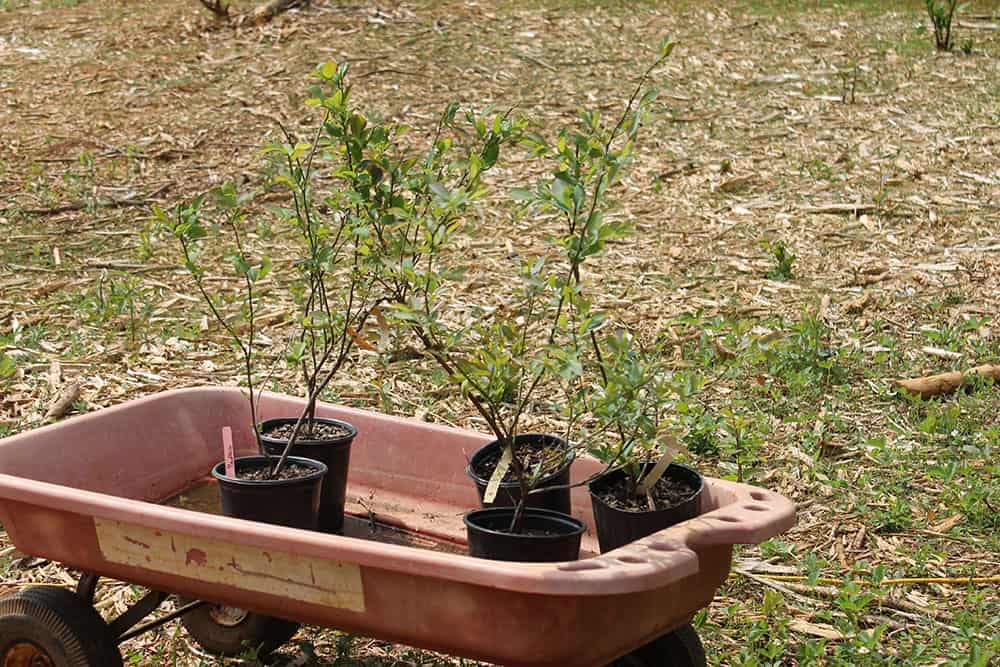
Choosing The Right Blueberry Plants
There are quite a few varieties of blueberries to choose from. You’ll want to select those that do best in your area. Do an online search for blueberry varieties in your county and you’ll likely find recommendations from your local county extension agency. You can always give them a call as well.
You’ll want to make sure you get different varieties for cross-pollination. Also, select plants that come into season at different times so you can extend the harvest over several months.
There are five major varieties of blueberries grown in the United States: half-high, lowbush, southern highbush, northern highbush, and rabbit eye.
Northern highbush blueberry varieties are some of the most common types of blueberry types. However, highbush varieties offer the best disease resistance.
In addition, most highbush cultivars are also self-fertile. You can utilize cross-pollination from another cultivar to ensure large berry production, or choose another blueberry of the same type for optimal yield and sizes.
Neither lowbush nor rabbiteye blueberry bushes are self-fertile, meaning that you need a different cultivar of rabbiteye to pollinate. Lowbush varieties can be cultivated by both lowbush and highbush cultivars.
Lowbush varieties are short, true bushes that generally grow low to the ground – usually no more than a foot and a half in height. If you want the best chances at a high yield, you should plant multiple cultivars.
Lowbush blueberries require little pruning, although you may want to cut them back every three years or so. One of the most popular varieties is Top Hat, which is used for ornamental landscaping.
Ruby Carpet is another top pick and can be grown in zones 3-7, making it one of the most versatile types of blueberries.
Northern highbush blueberries, as you might expect by the name, are native to the northeastern and eastern portions of the United States.
These plants can grow up to nine feet in height, and require a great deal of pruning to stay productive. Common highbush cultivars include:
- Blueray
- Bluegod
- Bluecrop
- Elliot
- Duke
- Jersey
- Patriot
- Rubel
- Hardyblue
Southern highbush blueberries are hybrid plants with the ability to grow up to eight feet tall.
They are best for berry production in areas that experience mild winters, as they require less chilling time in order to break bud and flower.
They blossom in the late winter- much sooner than other types of blueberry plants – and are suited to mild climates. Common cultivars include:
- Oneal
- Sharpblue
- Ozarkblue
- Sunshine Blue
- Misty
- Golf Coast
Rabbiteye blueberries are generally found in the southeastern portions of the United States, growing up to ten feet in height.
Like southern highbush blueberries, these plants are designed for areas with mild winters, but they also like being grown in places that experience long, hot summers.
They can suffer from winter cold damage, but most have thick skins and large seeds. Common types include:
- Climax
- Powderblue
- Tifblue
- Premier
- Brightwell
The final type of blueberry, the half-high blueberry, is a cross between a lowbush berry and a northern highbush berry. It can handle temperatures as low as 35 to 45 degrees Fahrenheit (1.5 to 7 Celsius).
It only grows to about four feet tall, making it more manageable for most people, and can be grown in containers, too. It needs minimal pruning. Some popular choices include:
- Polaris
- Northsky
- Northcountry
- Bluegold
- Patriot
- Northland
- Friendship
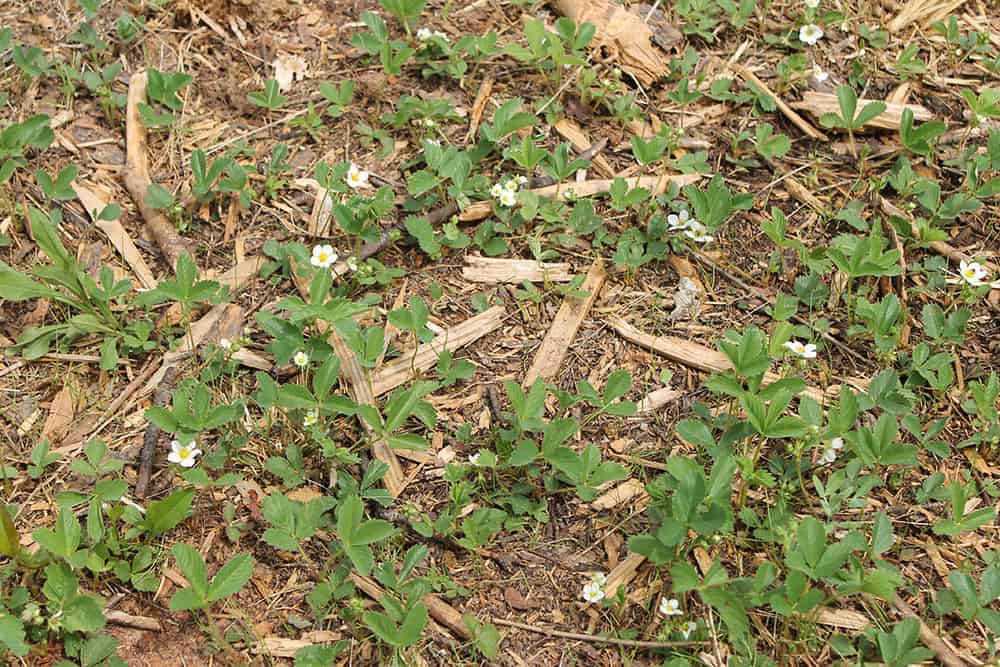
Site Selection
Blueberries need full sun. Plant blueberry bushes where they’ll get at least six hours of full sunlight for the best harvest.
They also need well-draining soil. Don’t plant them where they’ll stay soggy, such as a low-lying area of the yard.
In some cases, you may be able to plant blueberry bushes in partial shade, but this will vary depending on the climate where you live as well as what types of blueberry plants you are growing.
We picked a sunny spot up on the hill behind our house. There were lots of wild strawberries growing there and there had previously been pine trees, so we felt the soil was acidic enough. They say blueberries will grow where strawberries have done well because they both prefer acidic soil (4-5 pH).
You can have your county extension office do a soil test to see what amendments need to be made before planting blueberry bushes. It’s best to do this in the Fall and then test one more time before planting in early Spring.
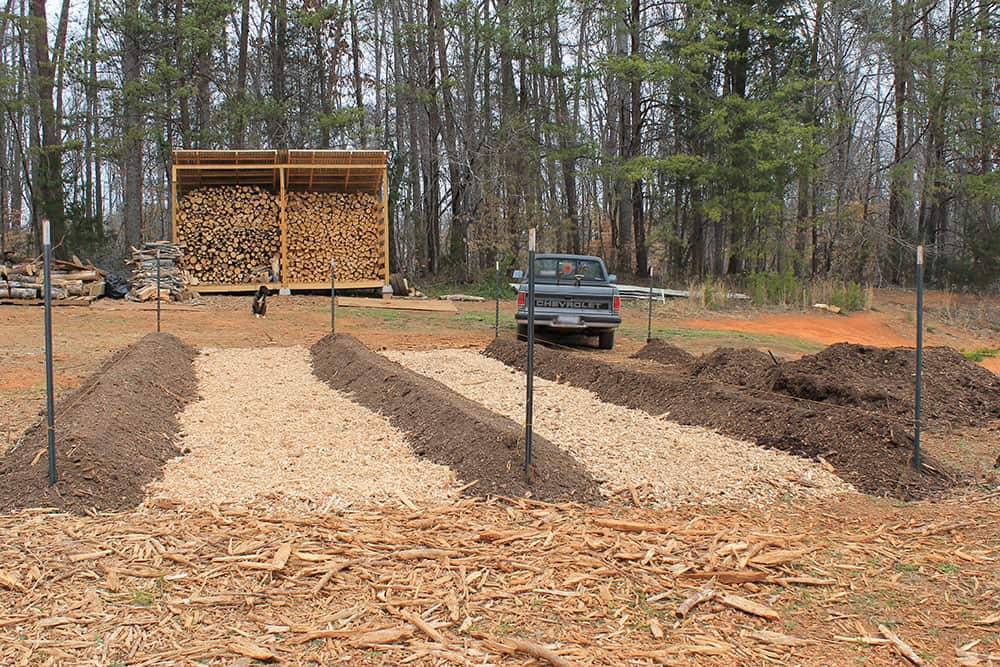
We started preparing the site by creating rows of compost and mulching between the rows with wood chips. The ground is super hard clay, and we thought the compost would help.
Later I read that you have to be careful when using compost with blueberry bushes as it can reduce the soil acidity too much. We ended up shoveling out most of the compost to just a couple of inches deep.
Blueberry bushes love moist, acidic, and organic soil. If your soil is not acidic, as I mentioned, you can add amendments to lower the pH.
Items like peat moss, finely-ground straight elemental sulfur, or pill-form elemental sulfur can all help do this.
In the past, some gardeners were encouraged to use iron sulfate or aluminum sulfate, but now, this is not recommended since it can cause plant toxicity.
Aim for about 3-20% organic content in the soil, too. Peat moss can, again, help with this, as can mulch, straw, leaf letter, or aged sawdust.
Blueberry bushes should be planted 4-6 feet apart, in rows 8-10 feet apart. We measured out the space for 20 plants, marked the rows with t-posts, and ran a string between them to keep the rows straight.
Another thing that’s important to note is that blueberries are self-pollinating in most cases. However, cross-pollination will produce a better crop with more berries and better yields.
Plant several types of blueberry plants with the same bloom time for the best results.
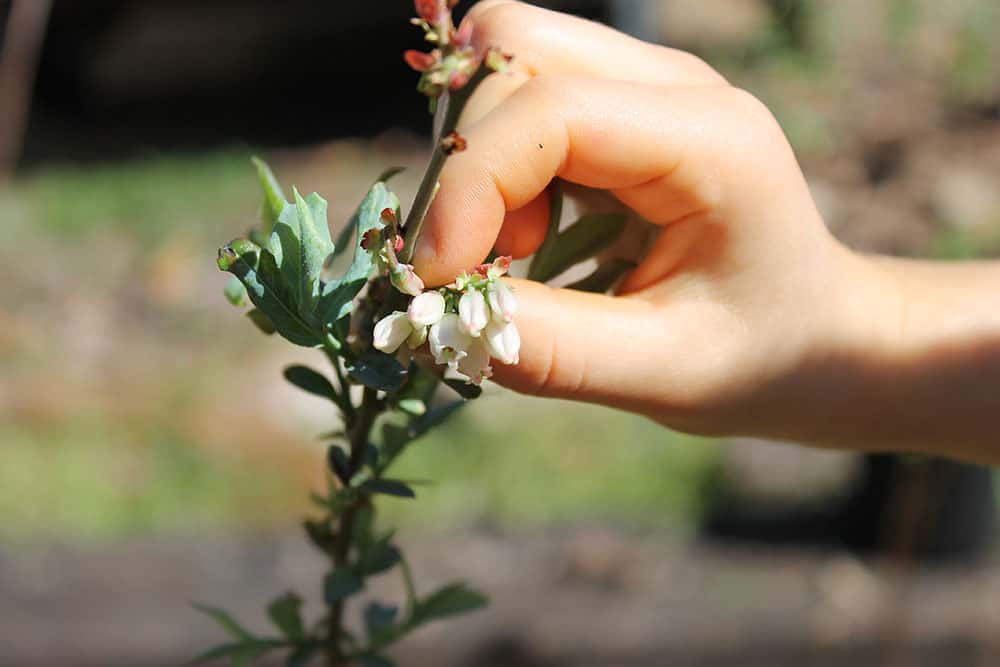
Preparing The Plants
The first thing you want to do before planting blueberry bushes is to pick off any blooms they might already have. I know this can be hard… but you really want the plant’s energy to go into establishing strong roots during its first couple of years instead of trying to send its energy up into the fruit.
You’ll also want to prune off any dead or damaged branches.
The best time to plant is in the early spring. Once your plants arrive to you, try to plant them as soon as possible.
If you can’t plant immediately, make sure you keep them cool and the roots moist. A refrigerator is recommended for long-term cold storage.
Once your plants arrive, go ahead and soak them in water for at least three to six hours before planting. This will help revitalize the roots.
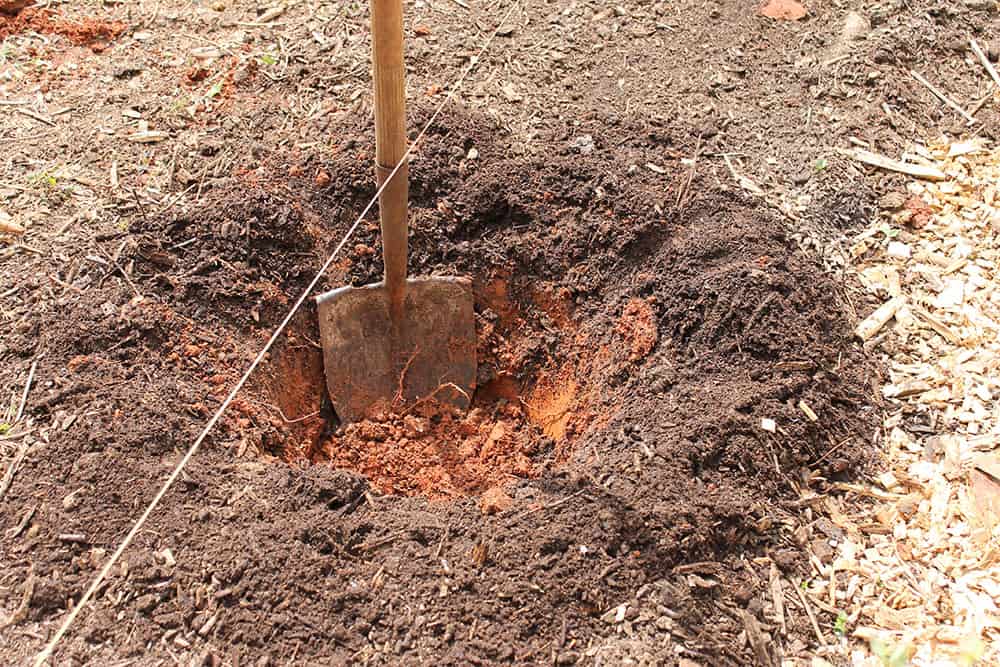
Planting Blueberry Bushes
Once you have your site selected and the plants are ready to be put in, the next step is to start digging! Dig the planting hole about 18″ across. It should be a little larger than twice the size of the pot it’s in.
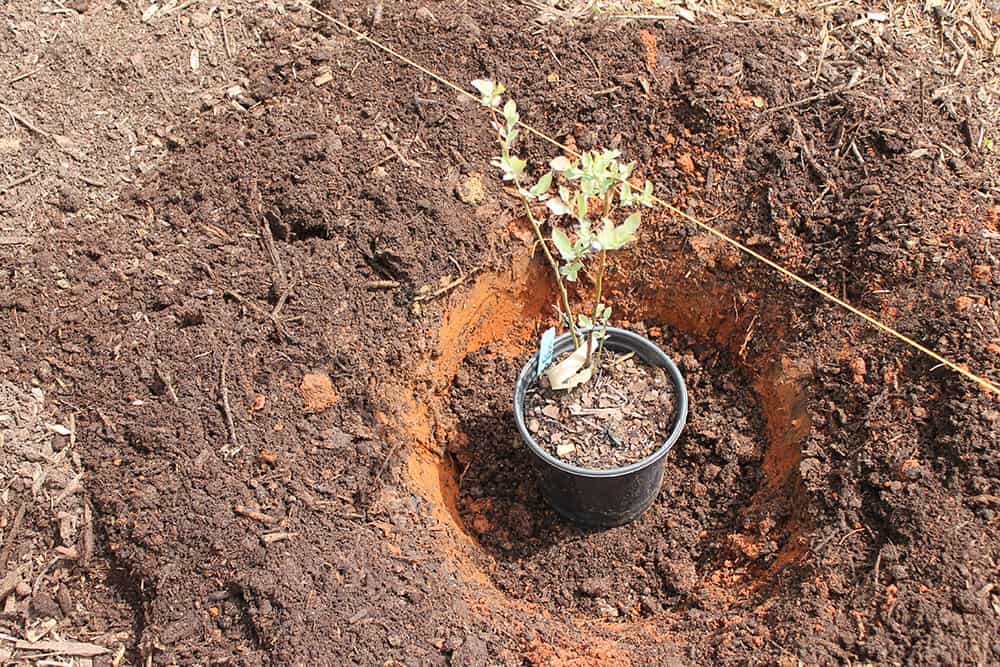
Dig the hole just a tad bit deeper than the pot (or just above the roots if planting bare-root plants). Put the plant in the hole to make sure it’s slightly below ground level.
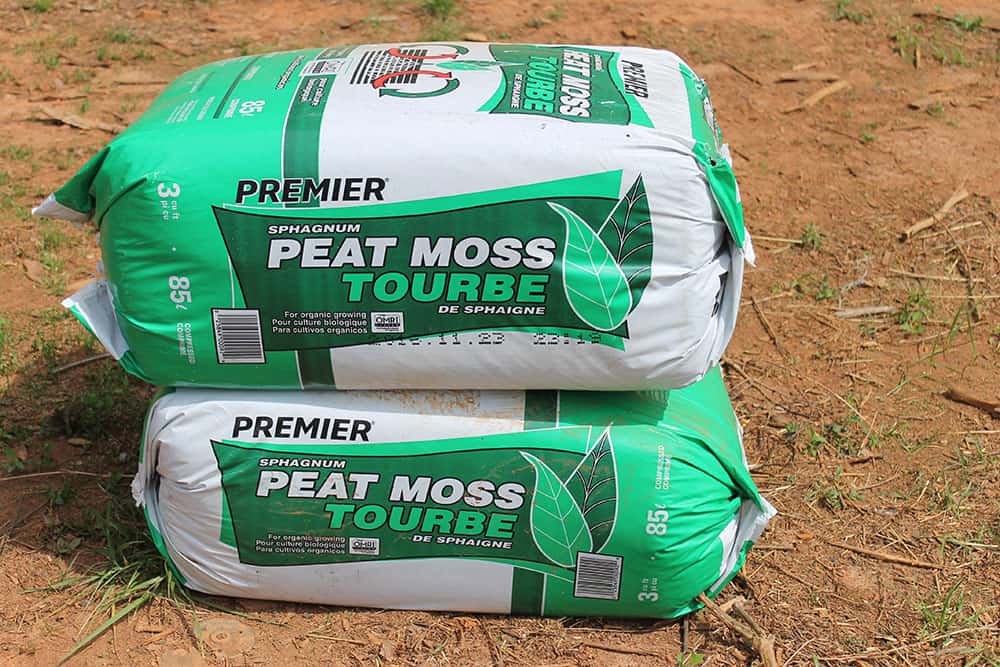
As I mentioned earlier, it’s recommended to add peat moss to the soil when planting blueberry bushes to help with acidity.
It should be thoroughly moistened before being mixed into the soil, otherwise it’ll sap all of the moisture out of the ground and away from the plant.
I dumped a bag of peat moss into an empty trash can, sprayed it with the hose, and mixed it with a shovel until it was the consistency of oatmeal.
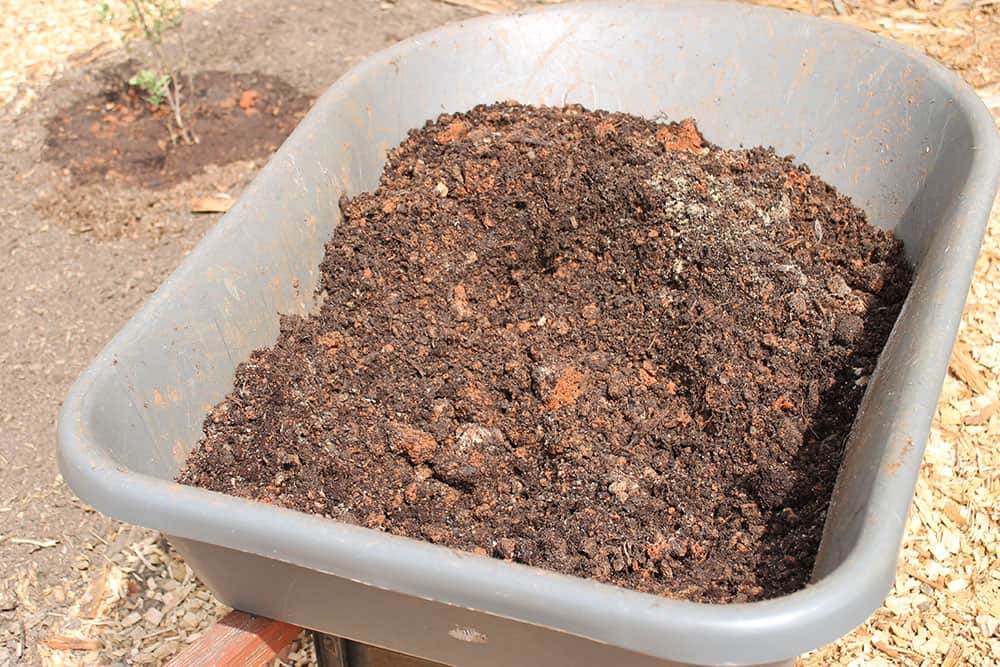
Mix equal parts of dirt from the planting hole with moistened peat moss. I also added a shovel full of sand because our ground is such hard clay. Sand helps to break up the clumps and allows for better drainage.
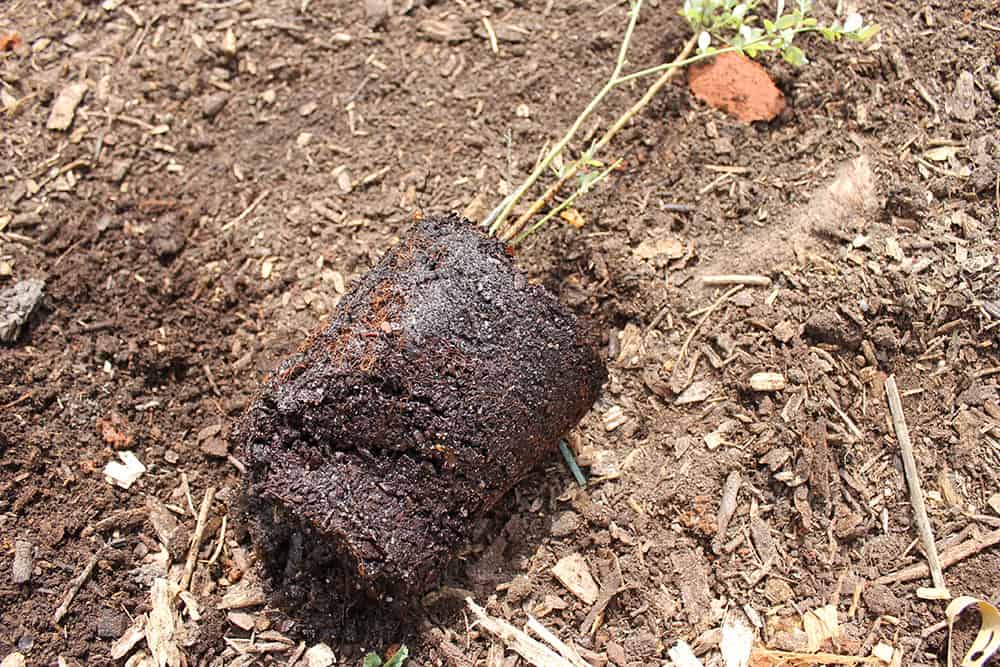
Water the plant to make sure the root ball is moist before planting. If you’re working with bare root plants allow them to soak in a bucket of water for an hour or so before planting (or follow the nursery’s instructions in that regard).
Gently squeeze the pot and tip it over so that the plant slides out. Avoid pulling on the plant itself. I like to break up the bottom of the root ball so that the roots don’t continue to grow around and around in the shape of the container they were in, which can choke off the plant.
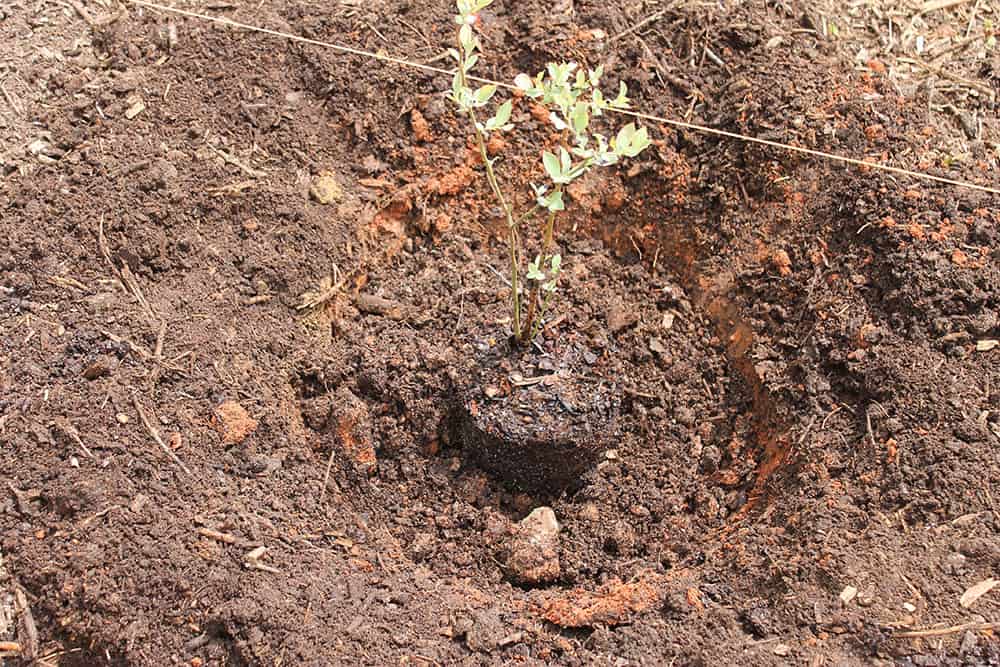
Add a little of the mixed soil to the bottom of the planting hole, just enough so that the plant will sit flush with (or just a tad below) the ground level. Then begin back-filling the hole with the soil mixture.
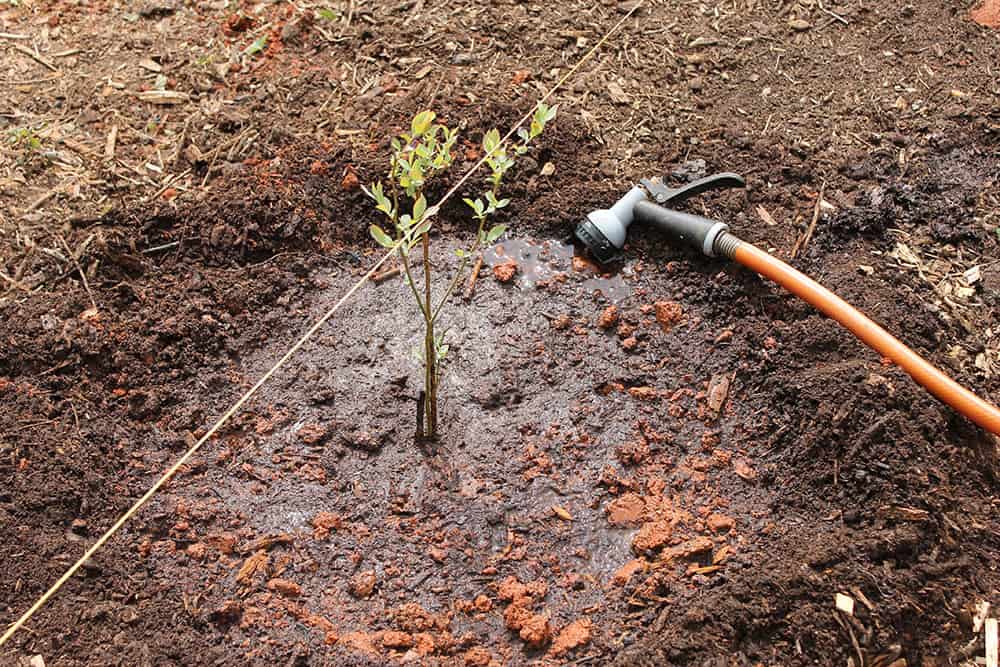
Once the hole is filled in around the plant give it a good watering. If the soil level drops add more dirt as needed.
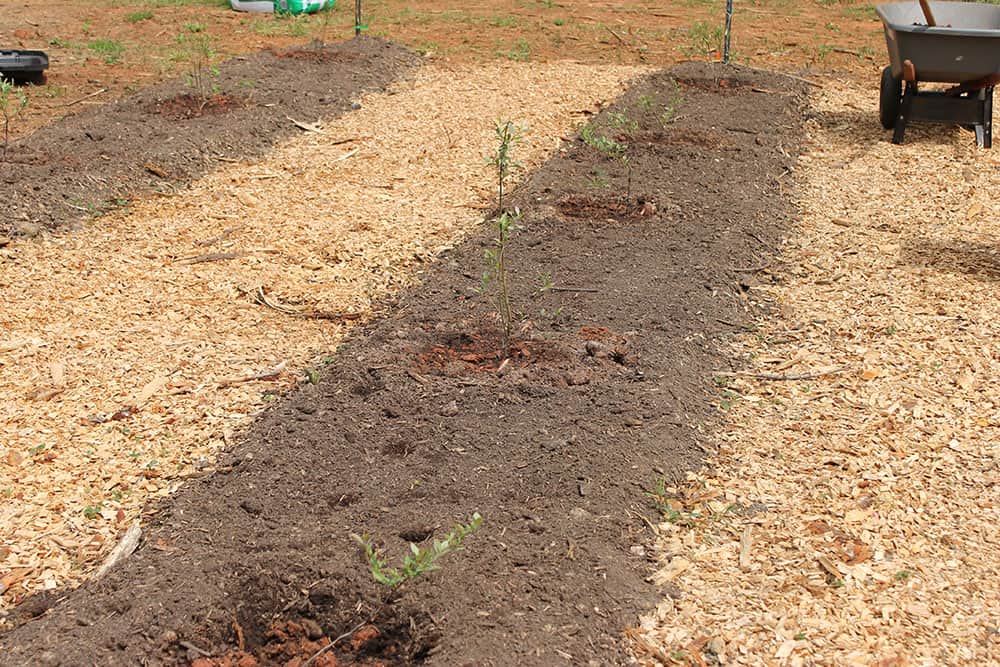
As you plant, you don’t need to step on the soil or tap it down. Just let it settle on its own. After planting, give another deep drink of water – at least one or two inches’ worth.
Continue to do the same with the rest of the blueberry bushes.
Watering Blueberries
Blueberry plants have thread-like roots with no root hairs. Since they have no root hairs, they are incredibly sensitive to fluctuating levels of moisture in the soil. If you mulch – which I’ll mention in a minute – this can be helpful, but you also need to be vigilant about when and how you water your plants.
Ideally, you should water your blueberry plants during the early part of the day. Allow the soil to get moist but not soggy.
This is usually about an inch of water per week during the growing season and up to four inches while your fruits are ripening. The soil needs to be kept moist at a depth of one inch.
When you water, try to distribute the water on all sides of the plant. Too little water, especially when the buds are developing or when fruit is developing, can lead to tiny berries. Too much water can cause your berries to be large, but bland.
Weeding
Make sure you do your best to eliminate weed competition around your blueberry plants. Ideally, this should be done before you plant.
Again, blueberry plants have shallow roots, so you’ll need to avoid cultivating or hoeing around the plants any deeper than two inches. Simply pull the weeds out by hand. Mulching can help reduce weed competition, too.
Fertilizing
You should not fertilize your blueberries during the first year of growth. However, in later years, you can fertilize with a complete 10-10-10 fertilizer that is designed for acid-loving plants.
This should be done in the spring. Divide your dose, giving half as the buds first open and the second one month later. You can increase the amounts as the plants mature, providing just nitrogen on a regular basis.
Pruning
You don’t need to prune during the first two to four years of your blueberry plants’ growth. You just should remove damaged canes or those that are rubbing against each other.
Just remove the fat fruit buds during the first year, which will encourage vegetative growth and help your plants develop roots.
Remember that blueberry plants that grow in an upright fashion will become denser in the center, which can cause detrimental shading.
After your plants have been allowed to grow for a few years, you can prune them to control the crop and improve fruit quality.
After several years of growth and when your plants are mature, you can remove older central canes, pruning inwards.
This should be done in late winter or early spring when the plants are dormant. Fall pruning is generally not advised, as the fragile shoots can be killed by cold winter weather.
Protecting from Pests and Diseases
Blueberry bushes are pretty hardy, but you may need to take a few steps to keep the birds from consuming your crop.
Netting is usually recommended, as you can use it just as the fruits are starting to ripen. Tie it securely around the base of the plants to keep rodents out, too.
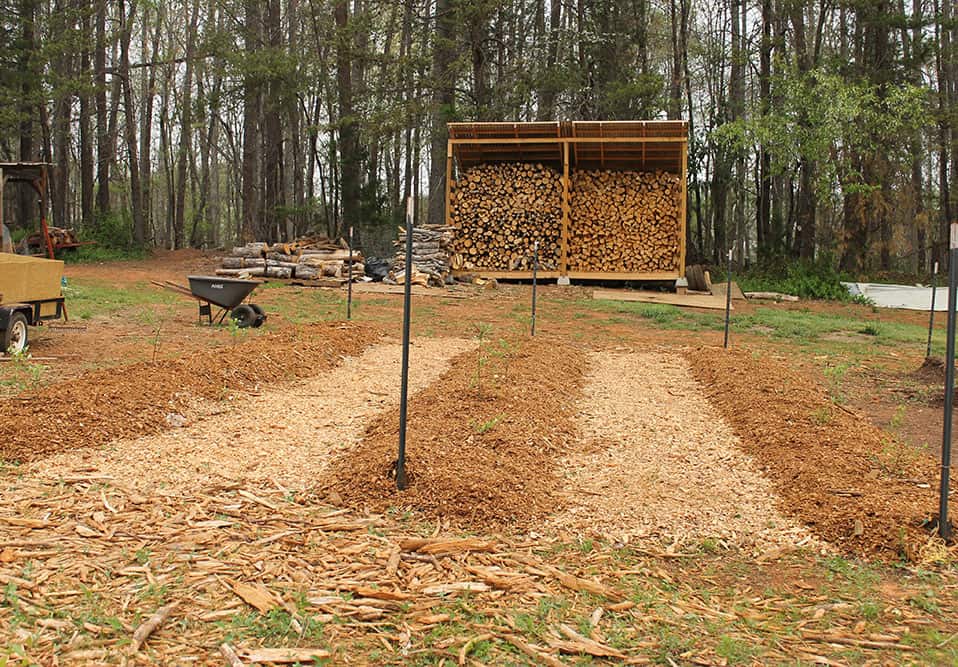
Mulching
Mulch to a depth of 4-6 inches to help conserve moisture, to keep weeds down, and to add organic material to the soil. Some good mulches for blueberry bushes are sawdust, wood chips (NO CEDAR), grass clippings, and pine needles.
Harvesting
Your blueberry plants, sadly, will not be ready until the second season of growth. At this time is when you will enjoy the best ripening and see a full crop.
Let your blueberries remain on the bush until they are completely ripe. Usually, you will want to wait up to seven days after the berries have turned completely blue for the highest levels of sweetness.
Make sure the stems aren’t red, green, or blue, or that the skin is not too dull looking. The berry should also detach easily from the plant.
Upon harvest, refrigerate your blueberries immediately. Freezing is also acceptable. You should not wash your blueberries until you are ready to use them, with refrigerated blueberries best when used within three to five days of harvest.
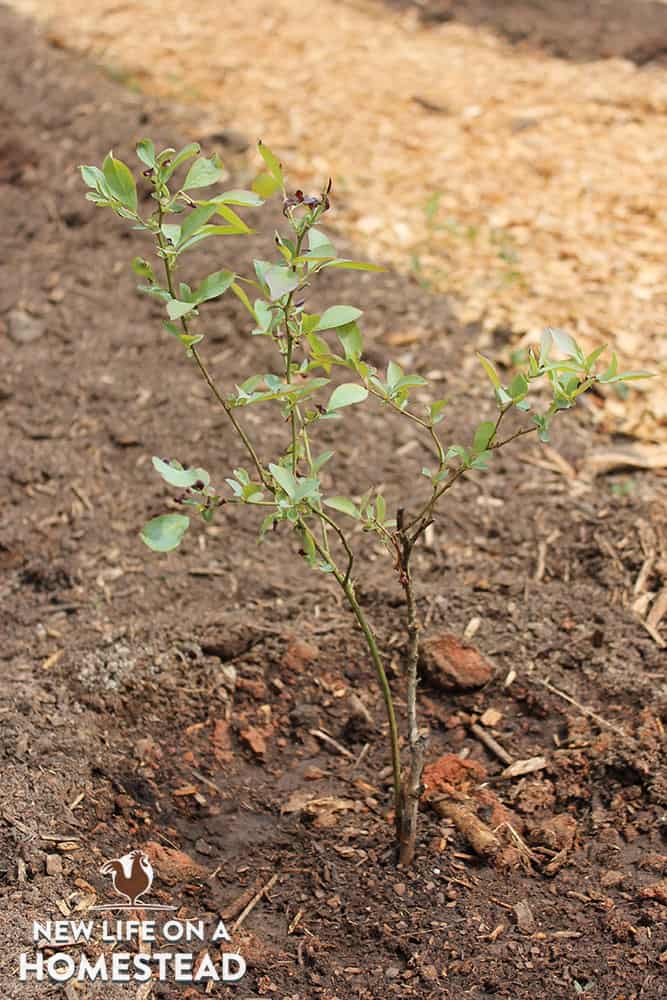
Other Tips
- Wait at least a month before fertilizing newly planted blueberry bushes.
- Water once a week if you haven’t had any rain.
- You won’t need to prune the bushes for the first four years.
- Pinch back the blossoms until the third growing year to increase future harvests.
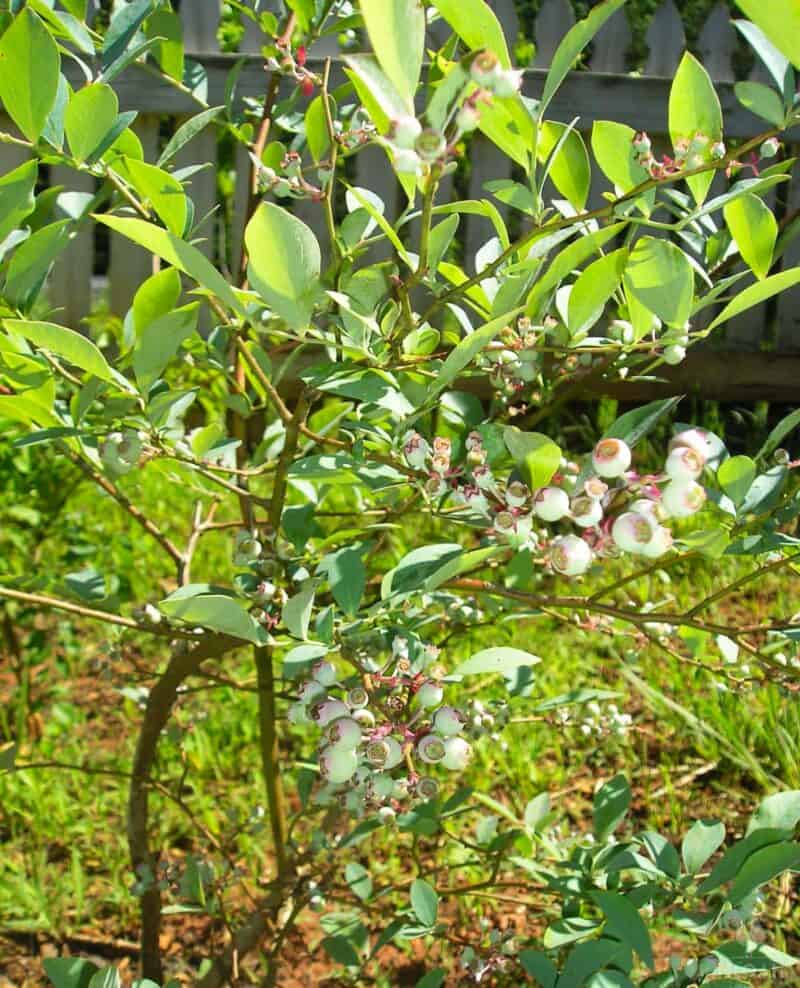
We’re super excited about our new patch! Planting blueberry bushes was hard work… I’m not gonna lie. Especially digging through hard ground with lots of roots. But I know it’ll be worth it.
I look forward to watching the kids gorging themselves on fresh, organic blueberries. It won’t be long before we have enough to make our favorite Honey Whole Wheat Blueberry Muffins!


A city girl learning to homestead on an acre of land in the country. Wife and homeschooling mother of four. Enjoying life, and everything that has to do with self sufficient living.

Hi,I’m reading the book Decoding Gardening Advice from Jeff Gillman and Meleah Maynard, and their advice for using peat moss is to apply it to the whole area, because the peat moss will change the density of the soil and the roots won’t develop correctly. Second you can use sulphur to decrease the PH in the soil to. I’m finding this book very helpful.
God speed gardeners!
Thank you for your article! What do you use to fertilize that bushes?
Thank you, Kendra, and others for such helpful hints about planting blueberries ! We have planted eight, and four have been in the ground for almost ten years, and they were of different varieties. Only one is producing well, and two of the four oldest plants have died. After reading your planting instructions, Kendra, and responses from your followers, it is quite obvious that we did not plant our blueberries in the most beneficial location. Our four oldest were just twigs, from the 4-H group in our area 🙂 First mistake, we did.. not pinching back the blooms the first 2yrs. so only one of those plants has grown to approximately five feet high, and that one has healthy looking leaves, but it has never produced blossoms. None of the four bushes have ever shown much growth, and two have finally died ! We definitely made some planting mistakes, and are wondering if there is anything we can do now to save the rest of our blueberries bushes..not going to give up 🙂 From the instructions from you, and your followers’, we will continue to figure out the proper ways for growing healthy blueberry bushes, and maybe we will eventually have more than a bowlful of blueberries 🙂 !
Thank you to everyone !
As usual, great information, in such a conversational manner…You make me feel like family! I just finished putting in 8 more bushes (several varieties), and hope the coons dont have dessert before my husband and I do. I use pine needle and oak leaf mulch in the holes, and all around the plants, as well as ash from our woodstove, and organic grass clippings from the acreage I mow. My older bushes produce very nice, large berries, over extended seasons. I cant wait till the new ones catch up. Thank you, Kendra, for sharing your journeys!! (You all, and Grandpa, remain in my prayers.)
Sounds like you’ll have a lovely blueberry patch as well, Grandma Susan. I love that you use all of the materials available to you to make your plants healthy and happy!
Receiving ten 3-year-old plants tomorrow, perfect timing. Thank you so much for sharing your methods!
Awesome!! I hope they do well for you.
I have a lot of rescued blueberry bushes from frustrated neighbors who gave up fighting with the deer, I put in a deer fence. One thing I noticed, they love growing with garlic.
Oh, good to know! I didn’t look up companion plants for blueberries… great tip!
As someone who owns a u-pick blueberry farm, most of your instructions are dead on correct. Having consulted with some of the biggest experts on blueberries in the country I can make a few suggestions. If you have hard packed soil as you described, you should always replace the soil removed when digging the holes with equal parts of Peat Moss and sand. Also if you are planting a large quantity at once, renting a post hole digger is well worth the cost. I dug 100 holes in under two hours. Your spacing is based on old guidelines you can plant your bushes 30 inches apart or even as close as 24 inches. It helps cut down on the weeds and it is otherwise just a waste of space. Depending upon the age of the bushes when you plant them you do not need to pick the blossoms off. I planted three-year-old bushes and did not need to do so. I also would not fertilize the first year. Good compost will save you a tremendous amount of time with weeding but your wood chips should be at least a year old before you use them. Also FYI, most blueberry bushes are now self fertile though having multiple varieties is never a bad idea if for no other reason then to extend your season. If you want to preserve large quantities having a lot of the same variety allow you to have sufficient quantities at one time. If you have any questions please feel free to contact me. Good luck
Thank you so much for taking a moment to share your knowledge with me and everyone else here!! I truly appreciate your advice. Maybe when my plants are close to maturity, if there’s a lot of space still between them I can transplant some of the off-shoots to fill in the gaps. There’s a lot of information out there on the web, often conflicting. It’s nice to hear from an expert on the matter. Thanks again!
so excited to watch these grow with you!
Thank you!!! I can’t wait ’til they’re big! 🙂